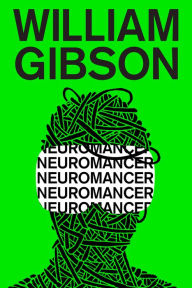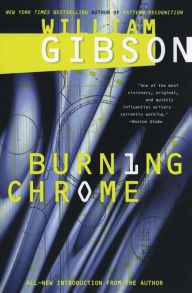The Future, Unevenly Distributed: William Gibson’s Neuromancer at 35
 When Neuromancer was published in 1984, its author, a newbie writer named William Gibson with not many credits to his name other than a few short stories, didn’t expect much of his debut novel.
When Neuromancer was published in 1984, its author, a newbie writer named William Gibson with not many credits to his name other than a few short stories, didn’t expect much of his debut novel.
“I wrote [it] with absolutely no expectation that it would be in print twenty years later,” he wrote in the introduction to the 20th anniversary edition. This year, the book turns 35. It’s still in print—has never been out of print—and it still feels like a vital part of the firmament of speculative fiction, if not our wider and increasingly digitally obsessed culture. Not bad for, as Gibson put it in 2004, “a paperback original—that most ephemeral of literary units, a pocket-sized slab of prose meant to fit a standard wire rack, printed on high-acid paper and visibly yearning to return to the crude pulp from which it had been pressed.” Three-and-a-half decades ago, he wagered it would be lucky to connect with “some kindred soul or five. Probably in England.”
Neuromancer
Neuromancer
Paperback $8.99
It’s done a bit better than that. In fact, the response was more or less immediate. It picked up a hat trick of literary awards in its first year: the Hugo, the Nebula, and the Philip K. Dick; it was the first book ever to win all three. It coined a phrase (“cyberspace,” though technically the word first appeared in his earlier short story “Burning Chrome”) and codified a subgenre (cyberpunk). Read today, its picture of the future looks both anachronistic (the internet didn’t quite turn out the way he imagined it before it existed) and eerily prescient. It begat two sequels, Count Zero and Mona Lisa Overdrive, and vaulted Gibson into the rarified class of science fiction authors who are treated seriously by people who don’t read science fiction. It is, in other words, a classic.
It’s done a bit better than that. In fact, the response was more or less immediate. It picked up a hat trick of literary awards in its first year: the Hugo, the Nebula, and the Philip K. Dick; it was the first book ever to win all three. It coined a phrase (“cyberspace,” though technically the word first appeared in his earlier short story “Burning Chrome”) and codified a subgenre (cyberpunk). Read today, its picture of the future looks both anachronistic (the internet didn’t quite turn out the way he imagined it before it existed) and eerily prescient. It begat two sequels, Count Zero and Mona Lisa Overdrive, and vaulted Gibson into the rarified class of science fiction authors who are treated seriously by people who don’t read science fiction. It is, in other words, a classic.
It seems strangely fitting that Neuromancer came to be in 1984, the year George Orwell made infamous in his cautionary tale of authoritarianism. Certainly the two books don’t share much in the way of sensibilities, but their occupation of that near future space, just on the outer edge of the present’s cone of influence, feels like a convergence. (Here’s something that will bake your noodle: Neuromancer was published 35 years after 1984, and we are now 35 years from the publication of Neuromancer.)
I first read Neuromancer when I was in high school, a few years after it was first published. I was completely blown away by it; it felt like nothing I had ever encountered. Other futuristic science fiction I’d theretofore devoured had been more in a techno-utopian vein, full of gleaming white halls and magnificent inventions. While the world of, say, Asimov’s Robot books wasn’t perfect, their approach to technology was almost schematic: here are some rules; break the rules; heal the break. The use of technology was never casual in Golden Age science fiction; no one took it for granted.
Burning Chrome
Burning Chrome
In Stock Online
Paperback $18.99
Neuromancer by contrast details a world both high-tech and grimy, its technology existing not in service to some high minded ideal or facilitating the betterment of humanity, but nonetheless distributed unevenly through the meat and gristle of everyday life: inextricable, necessary, and inexorable. Per square inch, the book positively bristles with disruptive tech, but the disruption has been ameliorated by humanity’s insouciant and fickle ability to absorb the wondrous into the muck of the everyday. Gibosn imagined a near future that seemed on the edge of becoming, a flickering neon possibility just over the next bend, wonderful and terrible in equal measures.
Neuromancer by contrast details a world both high-tech and grimy, its technology existing not in service to some high minded ideal or facilitating the betterment of humanity, but nonetheless distributed unevenly through the meat and gristle of everyday life: inextricable, necessary, and inexorable. Per square inch, the book positively bristles with disruptive tech, but the disruption has been ameliorated by humanity’s insouciant and fickle ability to absorb the wondrous into the muck of the everyday. Gibosn imagined a near future that seemed on the edge of becoming, a flickering neon possibility just over the next bend, wonderful and terrible in equal measures.
I’ve revisited the novel every five years or so, returning to its future often enough that I’ve noticed its shift into anachronism even as it retains its prophetic qualities. Consider its vision of cyberspace: Gibson had already written short stories about the digital metaverse born in the connections between computers, but Neuromancer is where he really began to explore it as a sort of “consensual hallucination” or “a graphic representation of data abstracted from banks of every computer in the human system.” The term was, at first, a serendipitous phrasing, giving name to the still coalescing Internet. (Which has itself become so ubiquitous, the old guard of copy editors are finally admitting we probably don’t need to capitalize the I.) As the years have ticked by and we’ve grown inured to the brutal bandy of social media and the spam-filled inbox, “cyberspace” has taken on a retrograde cast, used solely by geezers and the hopelessly square.
But while this one coinage hasn’t necessarily held up, there’s a lot more packed into the novel that has. Science fiction tends to produce neologisms, new words to describe new technologies and concepts. This is even more heightened in Neuromancer, which borrows from hard-boiled detective fiction, its rat-a-tat dialogue and elegant slang. Gibson’s debut is a master class in giving you the shape of the world through invented terminology that nonetheless feels lived in and natural.
“You got zip to do with me and my kind, buddy. You’re rich enough to hire expensive razorgirls to haul my ass up here, is all. I’m never gonna punch any deck again, not for you or anybody else.”
Agency (Signed Book)
Agency (Signed Book)
Hardcover $28.00
What does that mean? It doesn’t matter: you know what it means. Our console jockey, Case, complains to Armitage, who has come to offer him something he can’t refuse: a chance to get back to cyberspace. You can feel the familiar shape of the tale—the world-weary flatfoot given one last job by an untrustworthy client (that old saw). But then Gibson veers from legible genre tropes into the oddness of his kaleidoscopic world, the inevitable consequences of the ubiquitous technologies our principles disregard precisely because of their commonplace nature.
What does that mean? It doesn’t matter: you know what it means. Our console jockey, Case, complains to Armitage, who has come to offer him something he can’t refuse: a chance to get back to cyberspace. You can feel the familiar shape of the tale—the world-weary flatfoot given one last job by an untrustworthy client (that old saw). But then Gibson veers from legible genre tropes into the oddness of his kaleidoscopic world, the inevitable consequences of the ubiquitous technologies our principles disregard precisely because of their commonplace nature.
Many of the characters in Neuromancer inhabit spaces on the spectrum between human and technological. Case, as a console jockey, views his body as meat, his talents evident only in the un/reality of cyberspace. Molly Millions, who filmmaking duo the Wachowskis would later Xerox (there’s an anacronism for you) to create the character of Trinity in The Matrix, is a bruiser, hired muscle, who nonetheless relies on flesh augmented with top down visual displays and extendable razor nails. Dixie Flatline continues as a digital construct after his death. 3Jane is the technologically-mediated embodiment of hedonistic adaption—the clone daughter of robber barons warped by corrosive wealth. The artificial intelligences Wintermute and Neuromancer enact their dubious and largely inscrutable agenda using the avatars of children, colleagues, and lovers—whatever they think will work, in their distributed brains. Armitage is fully human, pasted together over unthinkable trauma, semi-functional and ticking.
It’s this aspect of the novel that keeps me coming back: most of these technological mediations and iterations haven’t come to be, but they make manifest a kind of cultural dreaming about the future/present that, while specifically wrong, winds up being fundamentally true. We’re still grappling, often bloodily, with the technological medium we can quaintly call cyberspace/the web/the internet/a phone, but there’s nothing quaint about it. It’s a broken screen written in the heavens:
“The sky above the port was the color of television, tuned to a dead channel.”
William Gibson’s next novel, Agency, will be published in January 2020. Pre-order a signed copy here.


